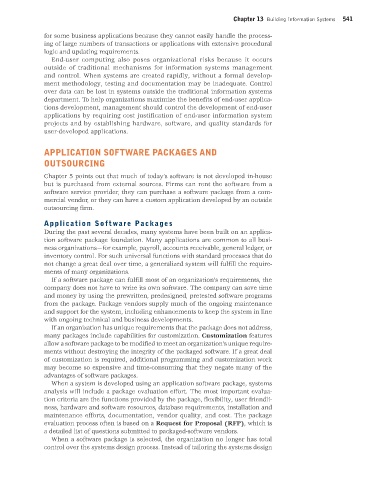Page 542 -
P. 542
Chapter 13 Building Information Systems 541
for some business applications because they cannot easily handle the process-
ing of large numbers of transactions or applications with extensive procedural
logic and updating requirements.
End-user computing also poses organizational risks because it occurs
outside of traditional mechanisms for information systems management
and control. When systems are created rapidly, without a formal develop-
ment methodology, testing and documentation may be inadequate. Control
over data can be lost in systems outside the traditional information systems
department. To help organizations maximize the benefits of end-user applica-
tions development, management should control the development of end-user
applications by requiring cost justification of end-user information system
projects and by establishing hardware, software, and quality standards for
user-developed applications.
APPLICATION SOFTWARE PACKAGES AND
OUTSOURCING
Chapter 5 points out that much of today’s software is not developed in-house
but is purchased from external sources. Firms can rent the software from a
software service provider, they can purchase a software package from a com-
mercial vendor, or they can have a custom application developed by an outside
outsourcing firm.
Application Software Packages
During the past several decades, many systems have been built on an applica-
tion software package foundation. Many applications are common to all busi-
ness organizations—for example, payroll, accounts receivable, general ledger, or
inventory control. For such universal functions with standard processes that do
not change a great deal over time, a generalized system will fulfill the require-
ments of many organizations.
If a software package can fulfill most of an organization’s requirements, the
company does not have to write its own software. The company can save time
and money by using the prewritten, predesigned, pretested software programs
from the package. Package vendors supply much of the ongoing maintenance
and support for the system, including enhancements to keep the system in line
with ongoing technical and business developments.
If an organization has unique requirements that the package does not address,
many packages include capabilities for customization. Customization features
allow a software package to be modified to meet an organization’s unique require-
ments without destroying the integrity of the packaged software. If a great deal
of customization is required, additional programming and customization work
may become so expensive and time-consuming that they negate many of the
advantages of software packages.
When a system is developed using an application software package, systems
analysis will include a package evaluation effort. The most important evalua-
tion criteria are the functions provided by the package, flexibility, user friendli-
ness, hardware and software resources, database requirements, installation and
maintenance efforts, documentation, vendor quality, and cost. The package
evaluation process often is based on a Request for Proposal (RFP), which is
a detailed list of questions submitted to packaged-software vendors.
When a software package is selected, the organization no longer has total
control over the systems design process. Instead of tailoring the systems design
MIS_13_Ch_13 global.indd 541 1/17/2013 2:31:24 PM

